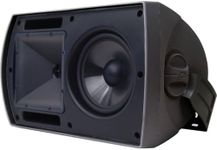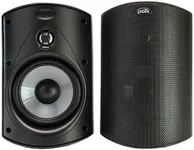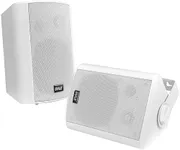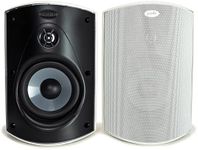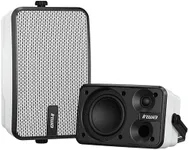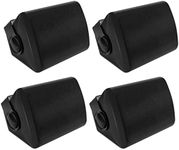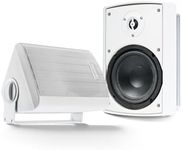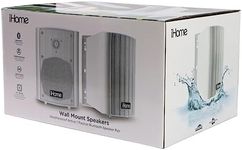Buying Guide for the Best Outdoor Wall Speakers
Choosing the right outdoor wall speakers can greatly enhance your outdoor entertainment experience. When selecting outdoor wall speakers, it's important to consider several key specifications to ensure you get the best sound quality and durability for your needs. Here are some important factors to consider and how to navigate them.Weather ResistanceWeather resistance is crucial for outdoor speakers as they will be exposed to various elements such as rain, sun, and humidity. Look for speakers with a high IP (Ingress Protection) rating, which indicates their ability to withstand water and dust. An IP rating of IPX4 or higher is generally good for outdoor use. If you live in an area with extreme weather conditions, consider speakers with an even higher rating. This ensures longevity and consistent performance regardless of the weather.
Sound QualitySound quality is a key factor in any speaker purchase. For outdoor speakers, you want a good balance of bass, midrange, and treble to ensure clear and powerful sound across a wide area. Look for speakers with a wide frequency response range (e.g., 20Hz to 20kHz) and high sensitivity (measured in decibels, dB). Higher sensitivity means the speaker can produce more sound from less power. If you plan to use the speakers for background music, moderate sound quality may suffice, but for parties or events, opt for higher-end models with superior sound quality.
Power HandlingPower handling refers to the amount of power a speaker can handle without distortion. It is measured in watts (W). Consider both the RMS (continuous power) and peak power ratings. RMS is more important as it indicates the power the speaker can handle over a long period. For small to medium-sized outdoor areas, speakers with 50-100W RMS should be sufficient. For larger areas or louder volumes, look for speakers with higher power handling capabilities. Match the power handling with your amplifier's output to avoid damaging the speakers.
Mounting OptionsMounting options are important for the ease of installation and the aesthetic integration of the speakers into your outdoor space. Look for speakers that come with versatile mounting brackets that allow for easy adjustment and positioning. Some speakers offer 360-degree rotation or tilt features, which can help direct the sound where you need it most. Consider the material and durability of the mounting hardware, especially if the speakers will be exposed to harsh weather conditions. Choose mounting options that fit your space and provide the best sound coverage.
ConnectivityConnectivity options determine how you will connect your speakers to your audio source. Traditional wired speakers require running speaker cables from your amplifier to the speakers, which can be more reliable but may involve more installation work. Wireless options, such as Bluetooth or Wi-Fi speakers, offer more flexibility and easier installation but may require a stable wireless connection. If you prefer a clean setup without visible wires, wireless speakers might be the best choice. Ensure the connectivity option you choose is compatible with your existing audio equipment.
Size and DesignThe size and design of the speakers can affect both the sound quality and the aesthetics of your outdoor space. Larger speakers generally provide better sound quality and volume but may be more noticeable and harder to install. Smaller speakers are more discreet and easier to place but may not deliver the same level of sound performance. Consider the design and color of the speakers to ensure they blend well with your outdoor decor. Choose a size and design that balances your sound quality needs with your aesthetic preferences.
